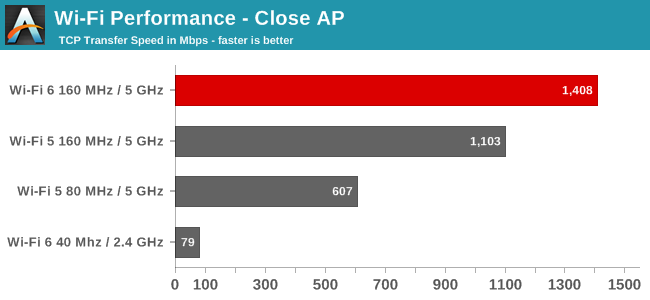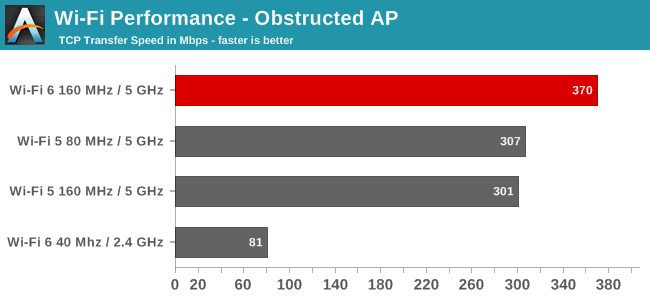AT 101: Wi-Fi 6 And Why You Want It
by Brett Howse on February 12, 2020 8:00 AM ESTPerformance
In order to achieve maximum performance, the latest Wi-Fi 6 standard leverages 1024-level QAM, but depending on the signal strength and quality it will scale down as needed, so to achieve the best performance very high signal to noise ratios are going to be required. Since 5 GHz is attenuated dramatically when it has to go through walls, if you need maximum Wi-Fi performance be aware that you are going to want your wireless router as close to the end device as possible. Luckily that is not an issue in our case, since the router is in the same room when testing for maximum performance, but we’ll also evaluate it in less than ideal scenarios as well.
Wi-Fi 5 vs Wi-Fi 6 – Close AP
First up we’ll test the TCP performance when the Access Point is in the same room as the client.

The performance advantages of Wi-Fi 6 are clear. With the access point in the same room, the SNR is very good and the new 802.11ax standard can really shine. With 1024 QAM and 160 MHz channels, the performance is over twice as fast as the outgoing Wi-Fi 5 with 256 QAM and 80 MHz channels. It is very impressive to see a typical 2x2:2 connection well over the Gigabit barrier, and even though the AX200 network card is the first generation, Intel has already done a fantastic job tuning it. The theoretical maximum transfer rate with 160 MHz channels and 1024 QAM is around 1200 Mbps per connection, so a 2x2 can in theory hit around 2.4 Gbps, meaning there's still room for improvement. Since 802.11ax also can be used on the 2.4 GHz frequency, unlike 802.11ac, the same test was also done on 2.4 GHz, and the results were disappointing. 2.4 GHz can still offer 40 MHz channels, but it doesn’t seem like the AX200 could take advantage of any of that. For reference, the wireless adapter in the laptop was reporting -21 dBm, which is a strong signal, which makes sense since the AP is almost right next to the laptop.
Wi-Fi 5 vs Wi-Fi 6 – Reduced Signal
Moving the laptop further away, and adding several walls and doors in the way to attenuate the signal, the same scenarios were again tested.

With some walls in the way, 5 GHz gets attenuated quite dramatically, and the SNR in the second location was -78 dBm. With such a low signal, the Wi-Fi 6 connection wasn’t able to take advantage of the 1024-level QAM and would have had to drop down to a much lower set, reducing the number of bits per tone, and even though the total channel bandwidth was still 160 MHz, it was only marginally faster on 802.11ax than 802.11ac 80 MHz. 2.4 GHz is not as impacted by walls, and as such was able to maintain the same transfer rate, even though it was still quite a bit slower.
So the results are clear. Wi-Fi 6 can offer a significantly higher level of throughput than Wi-Fi 5, but in order to do so, it needs a strong signal. The Wi-Fi 6 still outperformed the Wi-Fi 5 in the second test with an attenuated signal, but the performance gain was minimal. 2.4 GHz still offers the best signal strength, and therefore would be able to connect further away, and through more obstacles, but doesn’t offer anywhere near the performance of the 5 GHz range. It will be interesting to see the Wi-Fi 6E devices with 6 GHz support when they launch. It will open up Wi-Fi to a wider set of frequency choices, but will offer even less range.










149 Comments
View All Comments
Nokiya Cheruhone - Wednesday, February 12, 2020 - link
Can't these things not look like turds?WiFi hardware is supposed to blend in the environment. Why does nobody produce a successor to the AirPort Extreme line that has secure firmware and high performance. Miss those days where you could simply buy an AirPort and it would be the most secure and least ugly solution.
ABR - Wednesday, February 12, 2020 - link
I was running an AEBS from 2009 until a few weeks ago. Last month I got a firmware update for it from Apple.Dug - Wednesday, February 12, 2020 - link
I agree. Netgear Orbi isn't bad though. Just too expensive at $650-700 for two units.Nokiya Cheruhone - Wednesday, February 12, 2020 - link
I have a thought that every vendor nowadays kinda treats firmware updates and security over the lifetime of the product like an afterthought, it's not even easy to compare these vendors because most consumers wouldn't care too much (or even know that there is something like embedded firmware in the first place).Nokiya Cheruhone - Wednesday, February 12, 2020 - link
How was your experience with Netgear devices?Makaveli - Wednesday, February 12, 2020 - link
I will only use Netgear router if I can load Asus merlin on it lol.They are slow at patching exploits and the stock firmware isn't great.
Makaveli - Wednesday, February 12, 2020 - link
And this is why I like Asus hardware that support Merlin firmware.He often release updates for exploits before even Asus can for the stock firmware.
I've been using Merlin firmware for 4+ years now on various routers and his timely updates is what has kept me there.
Makaveli - Wednesday, February 12, 2020 - link
Agreed with you here boss I hate the spider looking routers.name99 - Thursday, February 13, 2020 - link
The closest to the Apple experience these days appears to be Amplifi, the home version of Ubiqiti. Same aesthetics, ease of use, mostly bullet-proof. (And same lack of interest in weird tweaks and claims of things that are supposed to improve games or whatever, but mostly don’t work.)They released an ax box maybe six weeks ago. I don’t have direct experience with it, but their ac box has been mostly trouble-free for me.
vFunct - Wednesday, February 12, 2020 - link
No latency measurements?